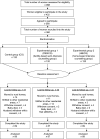Impact of counselling on exclusive breast-feeding practices in a poor urban setting in Kenya: a randomized controlled trial
- PMID: 23039968
- PMCID: PMC10271829
- DOI: 10.1017/S1368980012004405
Impact of counselling on exclusive breast-feeding practices in a poor urban setting in Kenya: a randomized controlled trial
Abstract
Objective: To determine the impact of facility-based semi-intensive and home-based intensive counselling in improving exclusive breast-feeding (EBF) in a low-resource urban setting in Kenya.
Design: A cluster randomized controlled trial in which nine villages were assigned on a 1:1:1 ratio, by computer, to two intervention groups and a control group. The home-based intensive counselling group (HBICG) received seven counselling sessions at home by trained peers, one prenatally and six postnatally. The facility-based semi-intensive counselling group (FBSICG) received only one counselling session prenatally. The control group (CG) received no counselling from the research team. Information on infant feeding practices was collected monthly for 6 months after delivery. The data-gathering team was blinded to the intervention allocation. The outcome was EBF prevalence at 6 months.
Setting: Kibera slum, Nairobi.
Subjects: A total of 360 HIV-negative women, 34-36 weeks pregnant, were selected from an antenatal clinic in Kibera; 120 per study group.
Results: Of the 360 women enrolled, 265 completed the study and were included in the analysis (CG n 89; FBSICG n 87; HBICG n 89). Analysis was by intention to treat. The prevalence of EBF at 6 months was 23.6% in HBICG, 9.2% in FBSICG and 5.6% in CG. HBICG mothers had four times increased likelihood to practise EBF compared with those in the CG (adjusted relative risk = 4.01; 95% CI 2.30, 7.01; P=0.001). There was no significant difference between EBF rates in FBSICG and CG.
Conclusions: EBF can be promoted in low socio-economic conditions using home-based intensive counselling. One session of facility-based counselling is not sufficient to sustain EBF.
Figures
Comment in
-
Feeding infants right--status and future directions.Public Health Nutr. 2013 Oct;16(10):1721-2. doi: 10.1017/S1368980013002358. Public Health Nutr. 2013. PMID: 23992410 Free PMC article. No abstract available.
References
-
- Jones G, Steketee RW, Black RE et al.; Bellagio Child Survival Study Group (2003) How many child deaths can we prevent? Lancet 362, 65–71. - PubMed
-
- World Health Organization (2004) HIV Transmission Through Breastfeeding: A Review of Available Evidence. Geneva: WHO.
-
- UNICEF (2011) State of the World's Children. New York: UNICEF.
-
- Central Bureau of Statistics Kenya, Ministry of Health Kenya & ORC Macro (2004) Kenya Demographic and Health Survey 2003: Key Findings. Calverton, MD: CBS, MOH and ORC Macro.
-
- Kenya National Bureau of Statistics & ICF Macro (2010) Kenya Demographic and Health Survey 2008–09. Calverton, MD: KNBS and ICF Macro.


